Art Fairs
Stan Lee Makes Final Appearance at New York Comic Con
The legendary comic creator bids the spectacle goodbye.
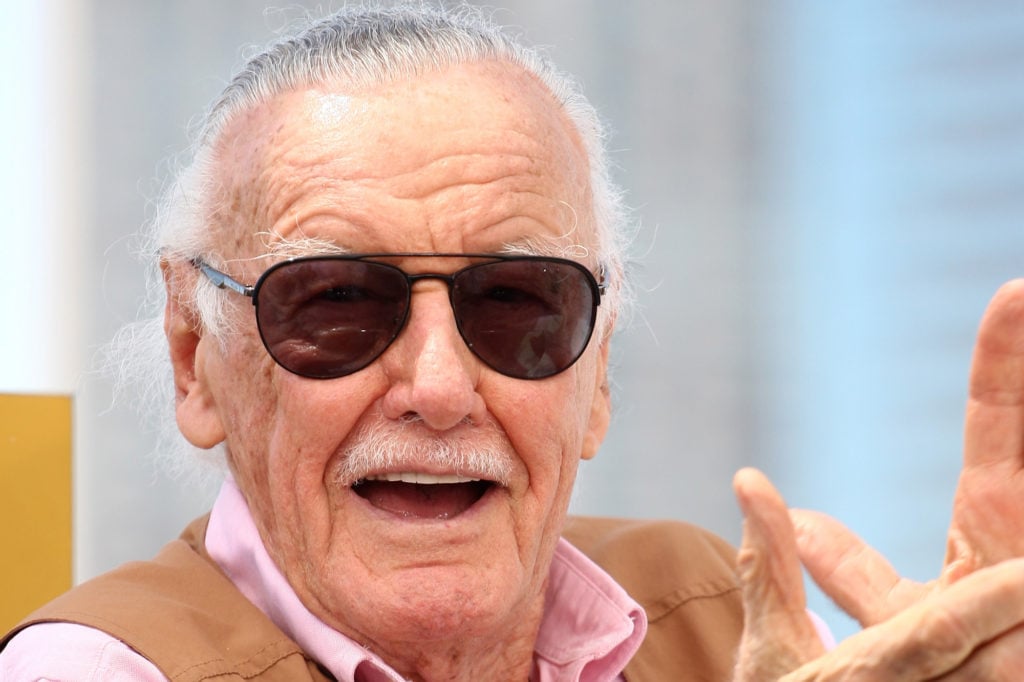
The legendary comic creator bids the spectacle goodbye.

Sarah Cascone

With the 2016 edition of New York Comic Con touching down at the Javits Center on October 6 comes the annual onslaught of artists, cosplayers, fanboys, and celebrities. It’s the last year, however, for one the con’s biggest draws, as legendary Marvel chairman and comic book creator Stan Lee has announced that this con will be his last in New York, the city of his birth.
The man who brought us such iconic characters as Spider-Man and the X-Men is now 93, and coming all the way to New York from his longtime home in Hollywood Hills just to sign a few autographs—even at $100 a pop—is becoming a tall order.
To understand what Lee means to comics, one needs to appreciate two things: that Lee brought a grittiness and emotional depth to the medium, and that he gave artists the freedom to draw scenes to fit a broadly outlined plot, filling in the dialogue afterward. The explosion of creativity that followed transformed the industry.
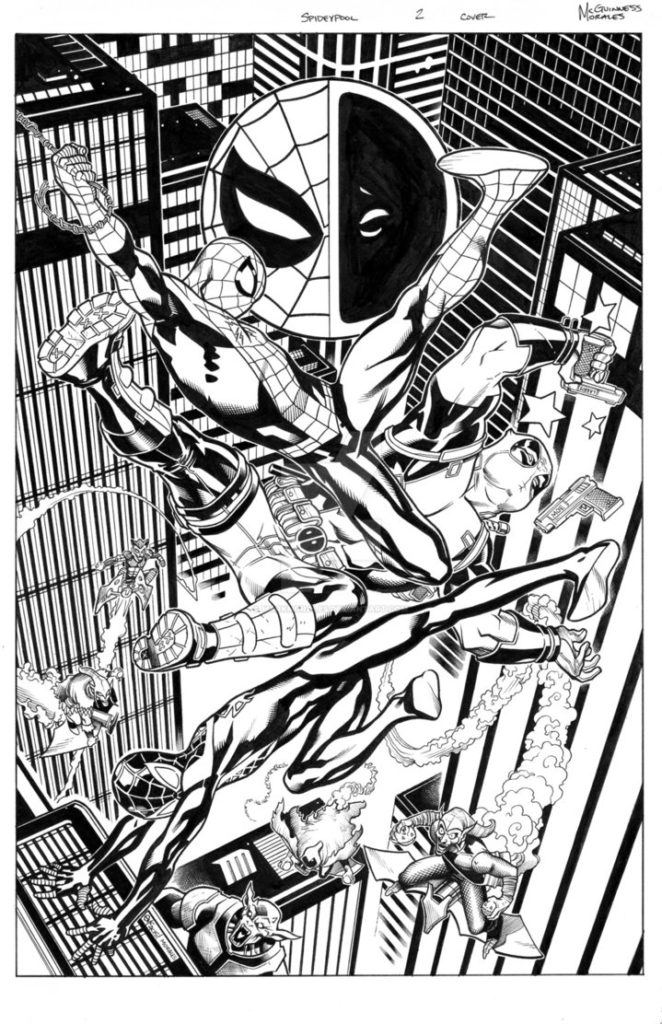
Mark Morales and Ed McGuinness, Spiderman/Deadpool #2 cover. Courtesy of the artist.
“The innovations that he did back then really opened it up to how it is now,” Marvel artist Paolo Rivera told artnet News from his booth in Artist Alley, where comic book artists can interact directly with fans.
There is, however, a dark side to the Stan Lee legend. Artist Jack Kirby, who drew the original comic books for The Fantastic Four, X-Men, and The Hulk, which he co-created with Lee, went on the record claiming that those iconic characters were his ideas, and that Lee had stolen all the credit. Kirby died in 1994, but his accusations still resonate, casting doubts about Lee’s legacy for at least some comic fans.
“When you’re a comics nerd, there comes a time in your life when someone more knowledgeable than you… lets you in on a secret,” wrote Vulture’s Abraham Riesman in a profile of Lee published earlier this year. “You know Stan Lee, right? You love him, right? Well, let me fill you in on some real shit.” What comic fans, and artists, make of these revelations can vary.
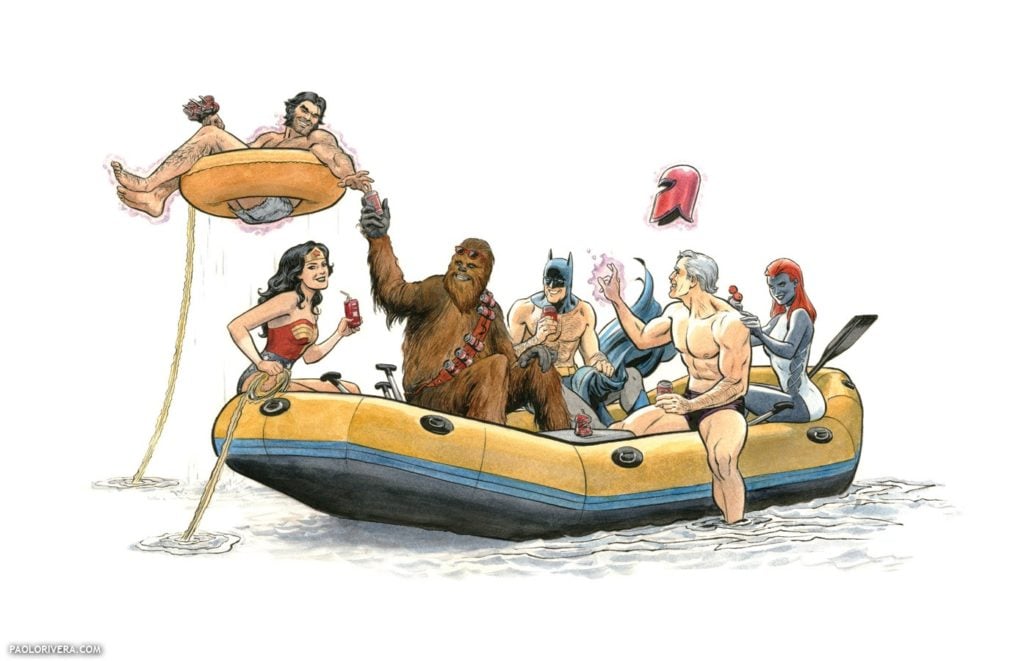
Paolo Rivera, Hella Rafting. Courtesy of the artist.
“I side with both of them for different reasons,” said artist Will Pigg, whose work features characters from Marvel comics, fairy tales, and Disney films, among other well-known cultural properties. He credits Lee with fueling the imagination of a generation of children and future artists, saying, “He was the one who brought a reality to fantasy.”
The range of characters featured at Pigg’s booth is reflective of the nature of comic con today. Beyond Marvel, DC, and indie comics, the convention has come to encompass everything from hit television dramas and fantasy films to sci-fi novels and anime. (For some, this trend has gone too far. artnet News overheard a woman complaining about con guests in Gilmore Girls and Gossip Girl costumes, which she derided as “CWP”—crazy white people.)
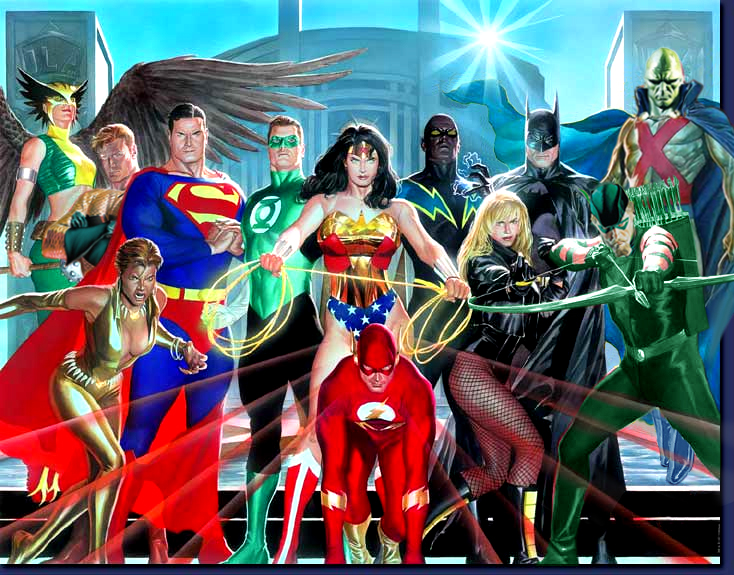
Alex Ross,
Justice League of America. Courtesy of the artist.
Clearly, the comic industry has to a certain extent outgrown Lee, but without him, “it’s tough to say if this would all be here,” said Rivera of the con. “Whether or not he took more credit than he should have… they were a team.”
Mark Morales, who draws for such Marvel titles as Spider-Man and The Avengers, thinks Lee’s contributions were an important part of the magic. Kirby’s post-Lee work, “doesn’t read as well” without Lee’s snappy dialogue, he told artnet News, noting that “there hasn’t been” any moment of disillusionment for him.
Current-day artists who talk about Lee are quick to pay lip-service to his legacy and acknowledge his support. “He came into my life at a time when I was ready to quit,” artist CJ Draden told artnet News of the time Lee endorsed his graphic novel Wooden Heart, a dark retelling of the Pinocchio fairy tale.
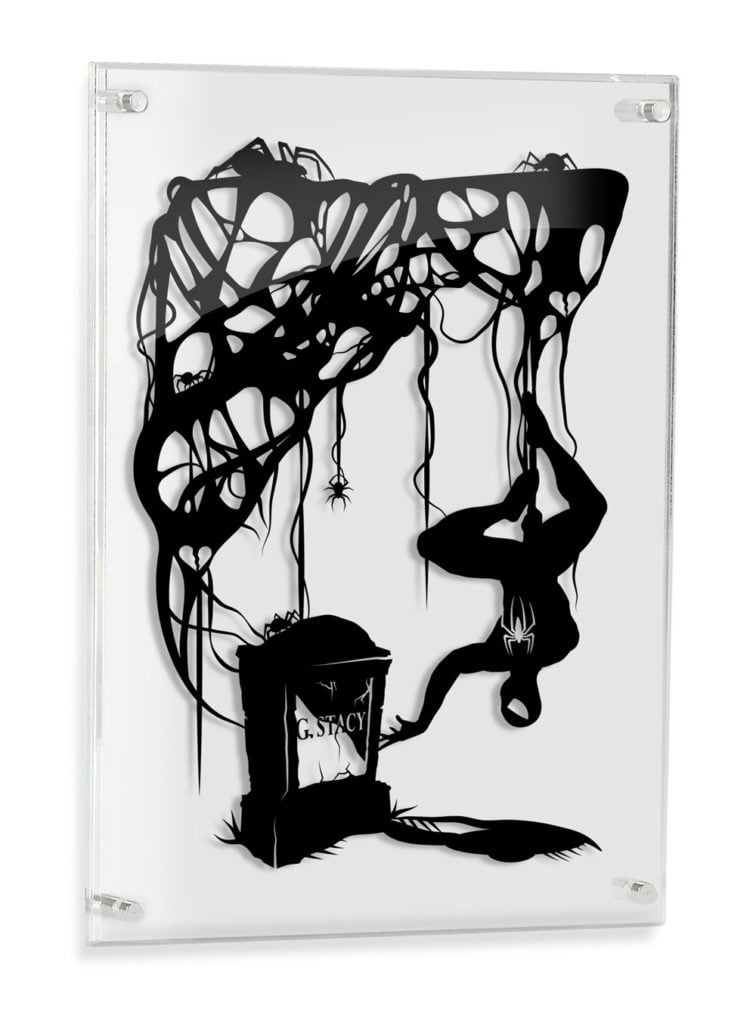
Will Pigg, Spider-Man Gwen Stacy Grave. Courtesy of the artist.
At his booth at the convention, Draden set up an easel to work on recent commissions: glass, etched monotype works that depict familiar characters in a more expressionistic style. “I didn’t really like the comicky look; it was too bubbly and fake,” said Draden about genesis of his artwork, which shows clearly the artist’s hand in bold, graphic strokes.
Pigg has a similar motivation, embracing less common media to create delicate cut paper silhouettes and charcoal illustrations that depict the characters in more emotional moments than might appear in the comics. “I like to give more of a fine art aspect to it,” he explained.
This trend clearly bleeds over into contemporary art, where comic style work and comic book characters are seen at almost every fair.
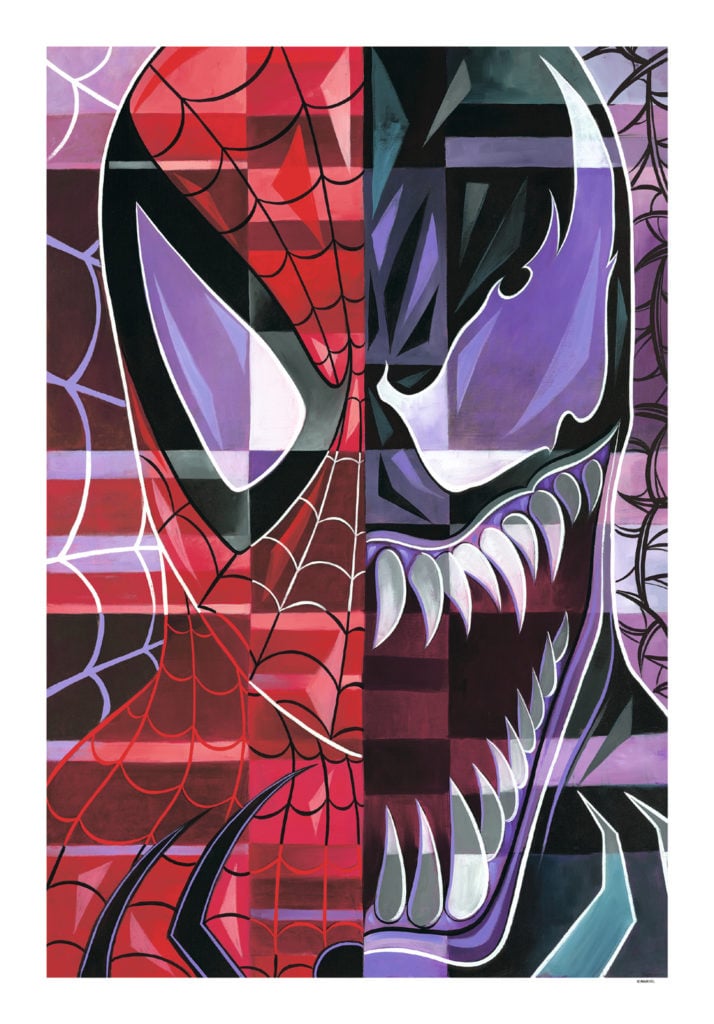
Tim Rogerson,
Spider-Man Venom. Courtesy of Marvel Fine Art.
Marvel too has seen the virtue of moving its characters beyond the page, launching the Marvel Fine Art gallery with Choice Collectibles nearly three-and-a-half years ago. The company sells fine art prints featuring Marvel characters from a handful of artists. Choice Art Group COO Ben Berman told artnet News that he hopes the venture can bring pop culture artists “artistic respect.”
“Everything goes through a rigorous approval process” with Marvel, Berman added, noting that Lee appreciates and respects the interpretations of his characters in various artistic styles. He cited Alex Ross, “the Norman Rockwell of comics,” and Tim Rogerson, whose work he described as Cubist-inspired, as prime examples.
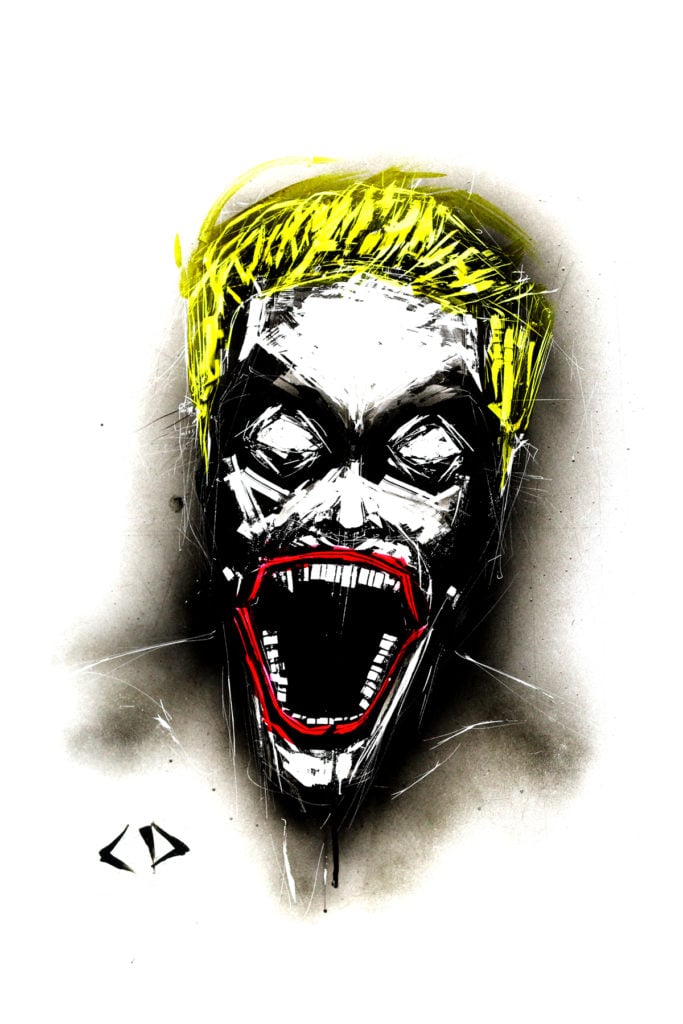
CJ Draden, Joker. Courtesy of the artist.
Berman believes Lee was instrumental in bringing comic art into the mainstream, where it has been embraced by artists and the public alike: “Stan’s vision in developing the characters, and his openness to adding emotional dimensionality, captured both the general public and the imaginative eye of the artist.”
Lee did not grant artnet News’s request for an interview, but we did get to see the man in person, during one of his many autograph signing sessions.
Near the front of the line, eager fans waited for more than three hours in hopes of a brief face-to-face with Lee. Each of Lee’s signatures required a $100 ticket, and the privilege of having a comic officially recognized and framed cost an extra $65. There are absolutely no photos, apparently even for members of the press, as artnet News learned the hard way.
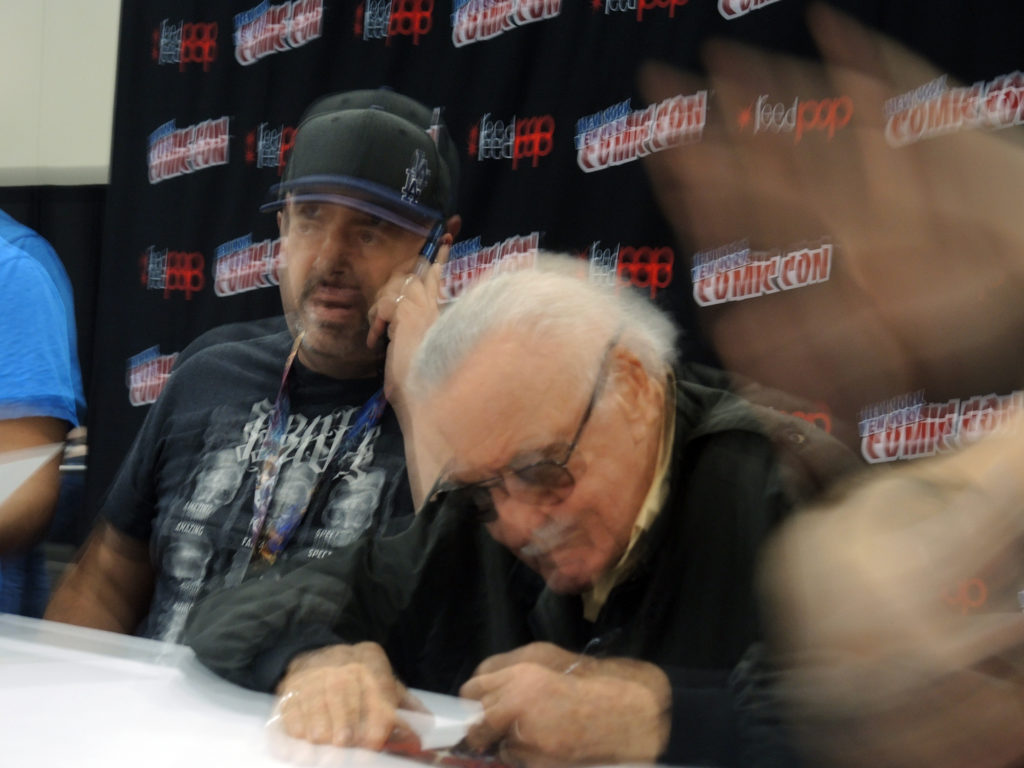
Stan Lee signs autographs at New York Comic Con 2016 as his handlers attempt to prevent artnet News from taking the comic legend’s photo. Courtesy of Sarah Cascone.
Lee works efficiently, mindful of the patiently-waiting crowd, and the money he stands to make. As I neared the head of the line, there was a pause in the flow of comics and memorabilia. “Why is there nothing in front of me?” he snapped at his team.
There were only a few seconds to be had with Lee. How did he feel about this being his final time here? “One last time!” he replied. Would he miss it? “Not really, not anymore. I’ve lived out there too long.”
Kirby is already long gone, and Lee’s story is also nearing its end, but NYCC will continue on without him. “They were there in the beginning,” said Rivera. “Now it’s morphed into something even bigger.”
See more photos of NYCC below.
New York Comic Con is on view at the Javitz Center, 655 West 34th St, New York, October 6–9, 2016.